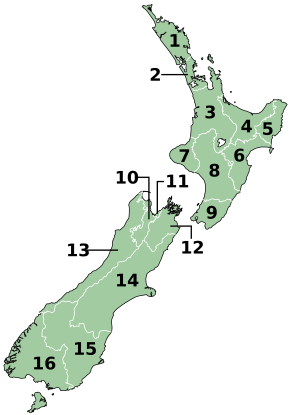Szerkesztő:Horv.petya/ujzeland/regiok
| Új-Zéland politikai élete |
|---|
 |
| Alkotmány |
| Kormány |
| Törvényhozás |
| Bíráskodás |
| Regionális szervek |
| Egyéb |
The region is the top tier of local government in New Zealand. There are 16 regions of New Zealand. Twelve are governed by an elected regional council, while four are governed by territorial authorities (the second tier of local government) which also perform the functions of a regional council and thus are known as unitary authorities. The Chatham Islands Council is often counted by many as a unitary authority, but it is officially recognised as a part of the region of Canterbury. Some regional boundaries follow territorial authority boundaries but there are plenty of exceptions. The southern boundary of the Auckland Region, for example, cuts through the middle of Franklin District.
Statutory basis[szerkesztés]
A regional council means one of the regional councils listed in Part 1 of Schedule 2 of the Local Government Act 2002.[1] Part 1 of Schedule 2 list the regional councils of New Zealand and their Gazette notices following their establishment in 1989.[2] The Local Government Act 2002 also requires regional councils to promote sustainable development - the social, economic, environmental and cultural well-being of their communities.[3]
Responsibilities[szerkesztés]
Regional authorities are primarily responsible for environmental management, including water, contaminant discharge and coastal management, river and lake management including flood and drainage control, regional land management; regional transport (including public transport), biosecurity or pest management; while territorial authorities are responsible for: local-level land use management (urban and rural planning); network utility services such as water, sewerage, stormwater and solid waste management; local roads; libraries; parks and reserves; and community development. Property rates (land taxes) are used to fund both regional and territorial government activities. There is often a high degree of co-operation between regional and territorial councils as they have complementary roles.
Resource management functions[szerkesztés]
Regional Councils have these specific functions under the Resource Management Act 1991.
- Planning for the integrated management of natural and physical resources [4]
- Planning for regionally significant land uses [5]
- Soil conservation, water quality and quantity, water ecosystems, natural hazards, hazardous substances [6]
- Controlling the coastal marine area [7]
- Controlling via resource consents the taking, use, damming or diverting of water [8]
- Controlling via resource consents the discharge of contaminants [9]
- Establishing of rules in a regional plan to allocate water [10]
- Controlling via resource consents the beds of waterbodies [11]
Other functions[szerkesztés]
Regional Councils also have responsibility for a number of other functions under other statutes;[12]
- regional pest management unde the Biosecurity Act 1993,
- flood and river control under the Soil Conservation and Rivers Control Act 1941,
- civil defence under the Civil Defence Act 1990,
- hazardous waste under the HSNO Acct 1996,
- harbour and water navigation under the Maritime Transport Act 1994,
- public transport planning under the Land Transport Act 1998, and,
- reserves vested in regional councils under the Reserves Act 1977.
Regional councils were also given responsibilities for the supervision of the safety of dams in the Building Act 2004.[13]
Régiók listája[szerkesztés]
 |
Region | Principal City | Area (km²) | Population(2) | ISO 3166-2 Code | |
|---|---|---|---|---|---|---|
| 1 | Northland | Whangarei | 13,941 | 152,700 | NZ-NTL
| |
| 2 | Auckland | Auckland | 16,140 | 1,371,000 | NZ-AUK
| |
| 3 | Waikato | Hamilton | 25,598 | 395,100 | NZ-WKO
| |
| 4 | Bay of Plenty | Tauranga | 12,447 | 265,300 | NZ-BOP
| |
| 5 | East Cape (1) | Gisborne | 8,351 | 46,000 | NZ-GIS
| |
| 6 | Hawke's Bay | Napier | 14,164 | 152,100 | NZ-HKB
| |
| 7 | Taranaki | New Plymouth | 7,273 | 107,300 | NZ-TKI
| |
| 8 | Manawatu-Wanganui | Palmerston North | 22,215 | 229,400 | NZ-MWT
| |
| 9 | Wellington | Wellington | 8,124 | 466,300 | NZ-WGN
| |
| 10 | Tasman (1) | Richmond | 9,786 | 45,800 | NZ-TAS
| |
| 11 | Nelson (1) | Nelson | 445 | 44,300 | NZ-NSN
| |
| 12 | Marlborough (1) | Blenheim | 12,484 | 43,600 | NZ-MBH
| |
| 13 | West Coast | Greymouth | 23,000 | 32,100 | NZ-WTC
| |
| 14 | Canterbury | Christchurch | 45,845 | 540,000 | NZ-CAN
| |
| 15 | Otago | Dunedin | 31,476 | 199,800 | NZ-OTA
| |
| 16 | Southland | Invercargill | 30,753 | 93,200 | NZ-STL
| |
|
(1) These regions are Unitary Authorities. | ||||||
Források[szerkesztés]
- ↑ Local Government Act 2002 Interpretation, retrieved 3 October 2007.
- ↑ Part 1, Schedule 2, LGA 2002, retrieved 3 October 2007.
- ↑ Relationship between the Local Government Act and the RMA Quality Planning The RMA Resource, retrieved 11 October 2007.
- ↑ Resource Management Act, Section 30(1)(a)- Parliament of New Zealand, 1991
- ↑ Resource Management Act, Section 30(1)(b)- Parliament of New Zealand, 1991
- ↑ Resource Management Act, Section 30(1)(c)- Parliament of New Zealand, 1991
- ↑ Resource Management Act, Section 30(1)(d)- Parliament of New Zealand, 1991
- ↑ Resource Management Act, Section 30(1)(e)- Parliament of New Zealand, 1991
- ↑ Resource Management Act, Section 30(1)(f)- Parliament of New Zealand, 1991
- ↑ Resource Management Act, Section 30(1)(fa)- Parliament of New Zealand, 1991. NB this is a new subsection added in 2005.
- ↑ Resource Management Act, Section 30(1)(g)- Parliament of New Zealand, 1991
- ↑ Harris, R. (2004) 'Local government and development legislation', Chapter 3G, Handbook of Environmental Law, Editor Harris, R., ISBN 0959785183, Royal Forest and Bird Protection Society of New Zealand, Wellington 2004, page 130.
- ↑ Sections 135, 142, 150, and 154 Building Act 2004, Parliament of New Zealand.
